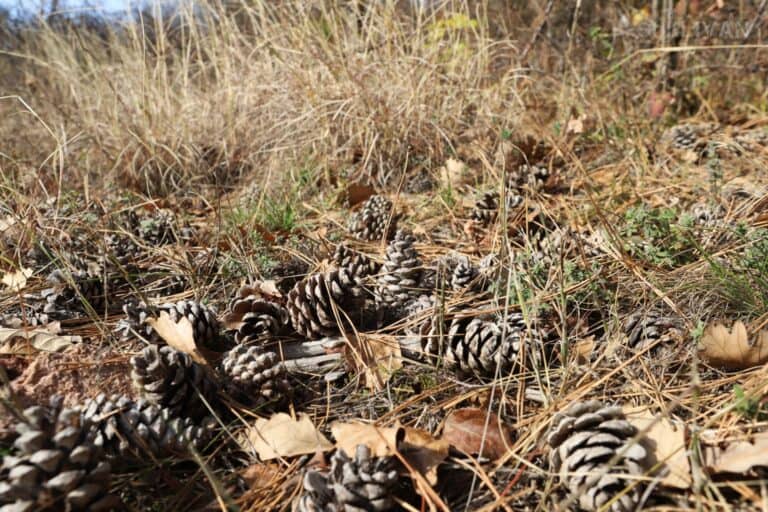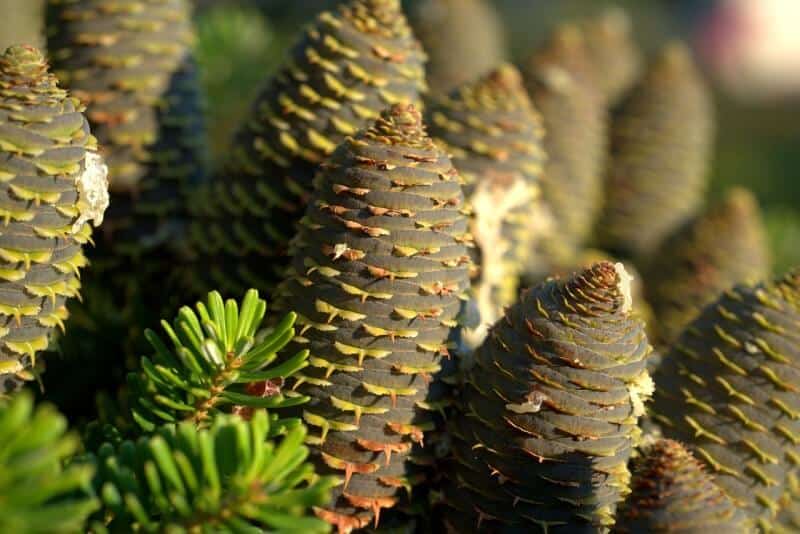If you’ve been lost in the woods for hours or even overnight, you know how quickly hunger can set in. According to all the experts, the average human can survive up to 3 weeks or longer without food.

I guarantee most of us will be trying to convince our stomachs we aren’t dying after five or six hours without the snacks it’s accustomed to getting at regular intervals.
So, as you wander through the forest, surrounded by pine trees, and realize that even if you can get your bearings you’re hours from your refrigerator, your stomach may have you wondering can you eat pine cones or not?
Yes, you can eat most varieties of pine cones. All parts of the pine tree are edible, though the cones aren’t necessarily the tastiest. However, yew trees, Norfolk Island pine, lodgepole pines, and ponderosa pine are poisonous and should be avoided at all costs.

Table of Contents
What is a Pine Cone?
If you’re going to try to eat a pine cone, you should first know a little bit about what a pine cone is and isn’t. Pine trees are coniferous trees.
Coniferous trees are found in the Northern hemisphere, including Europe, Asia, and North America. Forests of coniferous trees are referred to as boreal forests or taiga.
Over five hundred trees of various colors and shapes are classified as conifers and produce cones, not flowers, to develop and protect their seeds.
So, all trees in the conifer family, including hemlocks, spruce, cedars, firs, and pine will produce cones. These cones are essentially the hard outer shell of a seed pod. It’s the seeds inside that are most desirable.
But “pine cones” are exclusive to pine trees.
Cones can be male or female, and are typically found on the same tree. Female cones carry the seeds. Male pine cones are almost cylindrical in shape and narrower than female pine cones.
They are smaller, and softer than female pine cones most people are familiar with and almost resemble mini corn cobs. Pollen is released by male pine cones and is carried by the breeze to female cones.
So the first thing you need to know is not all “cones” are pine cones. Just remember, pine cones grow on pine trees. Makes sense, right?
Disclaimer
This is not medical or nutritional advice. Neither the author, the website publishing this article nor the company behind the website shall be held liable for any injuries, side effects, or even death as a direct or indirect result of the application of the principles in this article. The advice given in this article is for information purposes ONLY.
Where to Find Pine Trees and Pine Cones
Before you can decide whether or not to eat a pine cone, you need to know how to find some pine trees.
Found on the west coast, the sugar pine is one of the tallest edible pine trees in North America, reaching upwards of more than 200 feet and higher.
The longest pine cones, more than 2 feet long, come from the Sugar Pine. On the other side of the U.S., you’ll find the Eastern White Pine, which grows to over 200 foot and is found near the Appalachian mountains, north through Pennsylvania and as far as southeastern Canada.
The smallest pines are the Potosi Pinyon, native to parts of Mexico, and the Siberian Dwarf Pine, found in Siberia.
Other Edible Pine Trees Include:
- Western White
- Loblolly
- Red Pine
- Longleaf
- Pitch
- Slash Pine
- Jack
- Shortleaf
- Virginia Pine
Pine cones from pine trees come in various sizes too. Coulter Pines in Baja California are the biggest, some of those pine cones weigh more than 5 pounds and have scales that resemble daggers.
These are referred to as “widow makers”, because, well just imagine the damage it could do if one fell on your head as you walked underneath it.
Pine cones certainly don’t seem edible, do they? They are cone-shaped, pretty hard, and can be a little prickly if you hold them the wrong way.
Well, the male pine cones are smaller and softer, but still, who in their right mind would think you can eat pine cones?
In truth, pine cones were once a prized part of the dinosaur diet, especially for the “duckbill dinosaurs” or Parasaurolophus, whose rows of teeth were capable of chewing the tough pine cones.
And of course, pine cones are a favorite food source for many types of animals, including woodpeckers, crossbills, and squirrels. Pine needles and seeds are a food source for turkey, pheasant, and wood duck.
Okay, so dinosaurs ate pine cones. Many animals feed on pine cones. But does that mean the average human can eat pine cones or not?
So, Can People Eat Pine Cones or What?
The truth is that all parts of certain pine trees, including the pine cone, are indeed edible. This includes pine cones, needles, the inner layer of pine bark (not the outer layer!), resin, pine pollen (secret superfood!), and pine nuts. The pine cone may not be the best part to eat, but you can eat it.
Keep in mind that the pine cones are not there as a personal supply of crunchy wood to eat, pine cones are designed to do one thing. Hold the seeds of the tree until they are released for germination.
You really want to be after the seeds within the pine cones instead of the outer woody part. These are commonly called pine nuts and are used extensively in recipes such as pesto.
Unlike the dinosaurs, your teeth will have a tough time chewing it though. It’s best to grind pine cones or at least boil them to make them softer.
And no matter how you prepare them or eat pine cones, they are a terrific source of fiber and Vitamin C.
The seeds or pine nuts are much easier and tastier to eat though and are also a great source of vitamins and minerals.
Watch Out for Inedible Conifer Trees:
There are a few conifer trees that are different from the others in a critical way. They are poisonous! In your hunt for pine cones, be sure to avoid these pine trees which have poisonous needles or bark:
- Yew trees have straight needles that are flat and round and feather out; They also produce berry-looking structures not cones. While they are not true pines and are favored as popular garden plants, the seeds of the Yew are mildly toxic to both humans and domestic animals.
- Norfolk Island Pine is a conifer but not a true pine found on Norfolk Island in the South Pacific Ocean. It has been observed to cause medical distress in animals if ingested and there is a potential for skin irritation if handled with bare hands.
- Ponderosa Pines (also known as Blackjack Pine, Bull Pine or Western Yellow Pine) have long, fan-shaped needles. You’ll typically find cones covering the ground beneath a Ponderosa Pine. There is a potential for toxicity if you try to eat the cones.
- Lodgepole Pines. This is one of those trees that you don’t want to ingest at all. It contains isocupressic acid, which has proven toxic to cattle, primarily pregnant cattle. It is because of this toxicity that humans should not consume it.
How to Identify Pine Trees
Step One
Look for soft bundles of rounded needles in bunches of 2, 3, or 5. If the tree has single needles, it’s probably a spruce or fir. Pine needles are really soft and can grow to as much as 16 inches in length.
In comparison, spruce tree needles are square and much shorter, and rigid and originate from a single stalk-like point on the branch.
Fir tree needles are soft like pine needles but they are flat not round. Fir needles grow from a single point like the spruce but the point of attachment on the branch resembles a suction cup. Most fir needles also have white stripes on the bottom.
Step Two
Check the branches and pine cones of the tree in question. The branches on a pine tree will be less than the number of branches on a fir or spruce tree.
Branches on a pine tree also typically originate from a single, circular part of the tree trunk. Pine cones are green as they start to develop, but then turn reddish-brown or black.
Step Three
You’re getting good at this now, so here’s the short and sweet tip. Look for trees with a jagged triangular shape. If it looks like a classic bushy Christmas tree, it’s probably a spruce or a fir. If the pine cones are rigid and hard rather than thin and flexible, it’s likely a pine.
How to Harvest and Eat Pine Cones
Okay, now that you’re sure you’re looking at an actual pine tree with pine cones, let’s talk about how to harvest and eat the different parts of the pine tree.
You always want to harvest plants in the most responsible way in order to do the least amount of damage to the health of the tree.
Pine Cones
These aren’t the tastiest part of the pine tree. The best way to eat pine cones in a survival situation is to boil them to soften them. They can also be used as an Edible Garnish (choose young tender green pine cones).
If you’re looking to use the pine cone for its healing properties, make Pine Cone Jam (long used in countries such as Russia, Ukraine, and Georgia) by boiling the softer green pine cones.
Pine Pollen
This is in fact the superfood of the pine tree. Pine pollen is great for boosting your immune system and is a phenomenal source of vitamins and minerals.
Harvest pine pollen from about April to July when you can see it in the air. Place a plastic bag over the smaller male cones to collect the powdery, yellow dust.
Use pine pollen powder in cooking or make a pine pollen tincture.
Other Uses for Pine Cones and Pine Trees
In fact, in addition to eating pine cones and other parts, people have been harvesting pine cones and using parts in various ways for many years including:
- Meat Smoking/Seasoning
- Making Turpentine by distilling pine resin
- Waterproof canoes and add feathers to arrow shafts using pine pitch
- Lumber for building homes and furniture
- Stuffing garbage bags to make mattresses or pillows
- Mulch for garden or to raise pH of soil
- Tinder for Fire Starting
- Rabbit Food
- Making Pine Tar
- Basket Weaving
Have you ever tried to eat pine cones or another part of a pine tree? Tell us in the comments below which parts of the pine tree are your favorite.
Did you learn anything new from this article about whether you can eat pine cones or not? We’d love to hear your comments.

Born and raised in NE Ohio, with early memories that include grandpa teaching her to bait a hook and watching her mom, aunts, and grandmothers garden, sew, and can food, Megan is a true farm girl at heart.
For Megan, the 2003 blackout, the events of 911, and the increasing frequency of natural disasters like Hurricane Katrina, spurred a desire to be more prepared. Soon to be living off-grid, this mother of four and grandmother of ten is learning everything she can about preparedness, survival, and homesteading.

Very interesting,enjoyed reading it, would like to read more on the same type subjects.
Good luck trying to take a dump after eating a few pine cones. Better have some lard close by to ‘help’.
Very interesting. Would like to know more about making pine cone honey and jam. Thanks for sharing!
Thank you for such an informative and interesting article. I live in northeastern Massachusetts and we have two other kinds of pine species that can be found here. There is the Red pine (pinus resinosa) and the Mugo Pine (pinus mugo) the latter one being not native to the area but used as an ornamental low growing pine in landscaping which originates from the mountain region of Europe. Are these two species also edible as long as they aren’t sprayed with pesticides?
Interesting article. Good content. I lived alone in the woods living off the land. I drank a lot of pine needle tea made from the tender growing tip on the trees. Early spring tips are the best but all make a good tea. The early spring growth on the tips is also very tender and makes a good raw snack food to carry with you. I did sometimes use some inner bark cooked on a rock in my campfire. I had no containers to mix in so no real breads. I used some pollen in teas and roasted pounded inner bark in stews. Everything helps when nature is your pantry.
That’s amazing. Wow.. I would love to learn from someone like you. Foraging is so fun & interesting.
You can totally eat pine outer bark. It has been used for centuries to make flour. It is really delicius and most inportantly, you don’t harm a living tree by harvesting or, as occurs with cambium and inner bark collection. 😉
Thank you Elena, I believe this to be true as well. Take an orange for example, even though the peel is much less commonly eaten, it is much much higher in vitamin content than the inner fruit. The out bark would likely have a more dense vitamin/mineral/photochemical constitute to it as well.
The article was great! I’m curious to see pine cone jam in the future!
Fantastic article and comments- thanks!
I am wondering…I never hear much about the small male cones except for the pollen. Can I eat these little male cones? Can I pickle them into “caper-like” condiments?
thanks for all the other great info provided here!
This is a very interesting article! Do you know why species such as the ponderosa pine are considered to be poisonous as opposed to other pine species? Would eating a small amount of the bark be dangerous?
Thanks for the great information 🙂
Can the older woody pinecones of white pine be used to make jam?